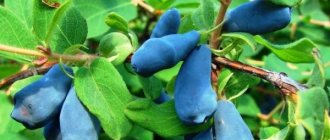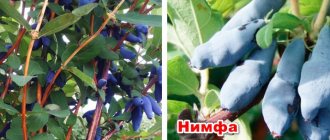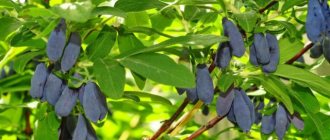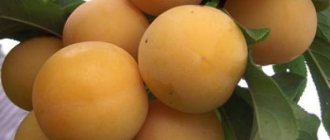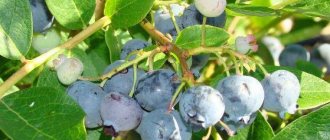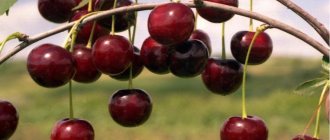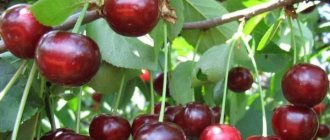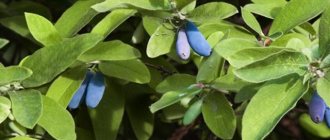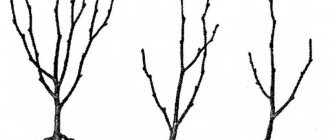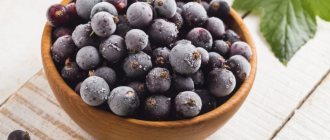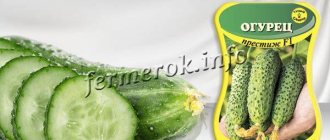Description of the variety
The Giant's Daughter is a hybrid of Turchaninov's honeysuckle and the Bakcharsky Velikan variety. The cultivar was accepted for State Variety Testing in 2009, and in 2017 it was included in the Russian State Register.
Specifications
Honeysuckle of the Giant's Daughter variety forms a fairly large bush, reaching 1.7 m by the age of 8-9, with an oval crown of medium density. In the first years it grows slowly, and although it is considered early-bearing, it produces a commercial harvest no earlier than 5-6 years after planting. It differs from other varieties in that at the beginning of the growing season, young shoots have a crimson hue, which is usually called anthocyanin.
The berries of the Giant's Daughter honeysuckle are considered one of the largest today, on average 1.8-2.5 g. This difference is due to the heterogeneity of the fruits, which have a characteristic shape similar to an inverted comma or an elongated pear. Productivity is 3.1-3.5 kg per bush or about 10.2 tons per hectare. Under particularly favorable conditions, up to 17 tons of berries can be collected from 1 hectare.
The fruits of the Giant's Daughter are dark purple, almost black in color, although due to the waxy coating they may appear bluish. The taste is dessert, sweet, with a slight sourness, without bitterness. The berries are suitable for processing or freezing, with average transportability.
The Giant's Daughter is a mid-late honeysuckle variety with extended fruiting. Harvesting is recommended to be done manually, in 2 stages. The berries are tightly attached to the branches and belong to the category of weakly shedding (losses up to 20%), but come off easily and cleanly.
Pollinators
Edible honeysuckles are self-sterile. When only one variety grows on a site, even with the best care and favorable weather conditions, the bush will bloom profusely, but will produce only a few berries. To obtain a bountiful harvest of honeysuckle, you need to plant at least 2-3 varieties nearby.
Flowers are pollinated by bees and bumblebees. There is no need to specially attract them - honeysuckle is an excellent honey plant and itself attracts beneficial insects to the site. The Giant's Daughter variety is best grown next to Bakcharsky Giant, Delight, Strezhevchanka.
Advantages and disadvantages
Honeysuckle berries from the Giant's Daughter are by far one of the sweetest and largest. Their original shape will prevent this variety from being confused with others. The advantages of the variety include:
- Large fruit and good taste – 4.8 points.
- Annual abundant fruiting.
- Honeysuckle berries are healing.
- Winter hardiness. The Giant's Daughter can withstand temperatures below -50 degrees without shelter.
- The variety is weakly shedding, the berries are firmly attached to the branches and are easily torn off without damage.
- Longevity - honeysuckle can bear fruit abundantly for up to 30 years.
The variety has few disadvantages:
- Self-sterility.
- Slow growth of honeysuckle in the first years after planting.
- Uneven ripening of berries.
- Up to 20% of the honeysuckle harvest falls off.
Important! Residents of other climatic zones are recommended to buy seedlings of the Giant's Daughter variety grown in local nurseries. It is difficult to adapt it yourself - leave this work to specialists.
Harvesting and transportation (shelf life), shelf life of berries
Honeysuckle is harvested by hand, carefully separating each berry from the stems. Despite the fact that the Giant's Daughter variety is not prone to shedding berries, since it has strong stalks, picking them from the bush is very easy. It is necessary to pick berries from the bush after they are fully ripe, since they cannot ripen when collected.
The peculiarity of honeysuckle berries is that they acquire a rich purple color a week before they are fully ripe. Considering that the transportability of the variety is average, it is better to immediately collect the berries in special trays and transport the crop to their destination in them. The berries are best stored in refrigerators, at temperatures from 0°C to +3°C and a high humidity level of 95%. The storage period is no more than 3 days, so the berries are usually processed or frozen.
Thus, honeysuckle of the Giant’s Daughter variety is easy to grow on your own plot, provided you follow the agrotechnical techniques and recommendations that are described in detail in the article.
Honeysuckle is a fairly common plant in temperate latitudes of the Northern Hemisphere. There are about 190 wild species, but only a few of them are edible. All of them are distinguished by the dark blue or purple color of the fruit, but due to the bluish coating they may appear blue. Red, orange and yellow berries are poisonous.
Recently, there has been an active creation of new honeysuckle crops; the Giant’s Daughter variety is considered one of the most promising.
Accommodation on site
Although honeysuckle grows best in its usual conditions - the Middle Zone, with the right approach it will produce a harvest even in the southern regions.
Selection of planting material
The best planting material for honeysuckle is 2-3 year old bushes with a closed root system. You need to buy plants in nurseries - this way there is less chance of getting into trouble with a variety or even buying an inedible variety. Choose honeysuckle with 2-4 even branches and equal internodes.
Important! The best planting time is late summer or early autumn.
Site selection and soil preparation
Good lighting of the area is the main condition for cultivating honeysuckle; otherwise, the plant is surprisingly undemanding. Any soil is suitable, but on sandstones fruiting will be weak. Optimal acidity is 5.5-6.6 (slightly acidic soil), acceptable is 4.5-6.5.
Honeysuckle should not be planted in lowlands and ravines - stagnation of water and accumulation of cold air will prevent it from developing normally. For the Giant's Daughter variety, manual harvesting is preferable; if mechanized harvesting is planned, choose a flat area. In regions with strong winds, plantings need protection during flowering and ovary formation.
Planting holes measuring 40x40x40 cm are prepared in advance, 1-2 buckets of organic matter are added to each (depending on soil fertility), 50 g of potash and phosphorus fertilizers. If necessary, deoxidize the soil with lime.
Planting a bush
Honeysuckle is not pruned before planting, but only broken branches are removed. They are very fragile, this must be taken into account. The standard planting pattern for the variety is 1.5 m between plants, 2.0-2.5 m between rows. In industrial plantings, plants are placed closer to each other, and row spacing is made large. But you still need to take into account the habit - the Giant’s Daughter variety has a tall and spreading bush.
It is better to start planting in late summer or early autumn, as soon as the heat subsides. Then the honeysuckle will have time to take root, and in the spring it will immediately begin to grow. The planting hole is filled with water, when the moisture is absorbed, a mound is poured in the middle, around which the roots are spread. The neck is deepened to 3-5 cm, soil is filled in, it is compressed, watered and the hole is mulched with peat or humus.
Agricultural technology
Honeysuckle is a picky plant, but good fruiting and active growth can only be achieved by following agricultural cultivation techniques, the features of which should be considered in more detail.
Choosing a location (taking into account humidity and lighting)
Honeysuckle bushes prefer to grow in well-warmed, moist and fertile soil. It is better to choose a place for planting that is sufficiently illuminated, with light shading of the lower branches, which is ensured by planting flowers or other low plants with a superficial root system that will not interfere with the normal development of the fruit bush. Shading at the base of the bush allows you to maintain a high level of soil moisture for normal growth of the bushes.
Honeysuckle plantings should be protected on the north side from strong cold winds by shrubs or buildings.
The soil for honeysuckle can be any, with the exception of sandy soil, which does not provide the root system with sufficient moisture and quickly loses its supply of nutrients. Slow growth and sickness of plants can be caused by acidic soils; the optimal acidity level for growing honeysuckle is within the pH range of 5.5–6.5. High groundwater levels are also detrimental to honeysuckle; choose elevated areas or create artificial embankments when planting bushes in areas where groundwater approaches the soil surface closer than 1 m.
Planting and care (watering + fertilizing)
The period for planting honeysuckle in open ground depends on the type of root system of the plant being purchased. If the bush has a closed root system, honeysuckle can be planted throughout the growing season. Provided that a seedling that has an open root system is planted, the procedure should be performed in the autumn, when the plant stops growing and enters the dormant stage - from late September to early October.
Let's consider the procedure for planting honeysuckle in open ground:
- A week before the planned date of planting the bush, holes should be prepared with dimensions of 40 cm in depth, 40 cm in diameter. The distance between planting holes should be at least 2.5 m, between rows 3–3.5 m.
- The planting pit is filled with drainage (expanded clay, crushed stone, broken brick). The height of the drainage layer must be at least 30 cm.
- Immediately before planting the seedlings, the hole is filled 1/3 with fertile soil, mixed with 2 buckets of compost, 50 g of superphosphate and 1 kg of ash. On sandy loam soil, the amount of compost should be increased to 3 buckets with the addition of 4 kg of clay per 1 m².
- The pits are watered generously with clean water at room temperature, in the amount of 2-3 buckets.
- In the center of the hole, make an elevation of soil, install a seedling, straighten the roots, and sprinkle with soil.
- While filling the planting hole with soil, it is lightly compacted to secure the seedling.
- The hole should be filled in such a way that the root collar rises 3–4 cm above the soil surface.
- The soil is watered again with 2 buckets of water, if necessary, soil is added around the tree trunk circle (if it sank after watering).
- The soil surface is mulched with sawdust or straw (a layer of approximately 6–8 cm) to avoid moisture evaporation and overgrowth of the tree trunk with weeds.
Read also: Brazil nut color photo
In the first 3-4 years after planting the plant, the bush does not require special care; it should only be watered in a timely manner and the area of the site should be weeded from weeds.
At this time, the above-ground part of the bush grows very slowly, since all its strength is spent on the formation of a strong root system. It is necessary to water honeysuckle bushes abundantly and regularly, since the plant is moisture-loving and does not tolerate drought well. A total of 4 waterings are required per season. The amount of water used for 1 bush should be 10 liters.
Plants need to be fed every 3 years, 2 times a season - in spring and autumn. Spring feeding consists of 10 kg of humus, which is applied under the bush while digging the tree trunk circle. In autumn, the tree trunk circle is fertilized with wood ash in the amount of 150 g per bush.
An adult plant can be additionally fertilized with mineral mixtures. Nitrogen fertilizing is applied in the spring on melting snow in the amount of 1 tbsp. l. for 1 bucket of water for each bush. Before honeysuckle begins to bloom (in the bud formation phase), you can apply foliar feeding with Master and Aquarin preparations according to the instructions.
Features of pollination
All varieties of edible honeysuckle are self-sterile, that is, they cannot bear fruit without the help of pollinating plants, which are usually planted in one area. One variety cannot pollinate itself, but if you plant several varieties of honeysuckle nearby, the yield will increase significantly. The best neighbors for the Giant's Daughter variety are Bakcharsky Giant, Vostorg, Strezhevchanka. In addition to pollinating plants, insects - bees and bumblebees - can help pollinate flowers.
Disease and pest control
Honeysuckle is highly resistant to diseases and pests, so problems with the plant usually do not arise. It is worth noting that only in rare cases, under conditions of improper care, does honeysuckle suffer from powdery mildew. For treatment, the plant is treated with “Fitosporin” according to the instructions.
Among the pests that can sometimes infect bushes are:
- leafroller, honeysuckle fingerwing, scale insect and honeysuckle mite. All of these pests are insects that suck plant juices, so they are controlled with identical systemic drugs, such as Confidor or Actellik, according to the instructions;
- aphids - a pest most often affects bushes during the fruiting period, when it is impossible to use chemicals to kill insects, so as not to spoil the harvest. To preserve the berries and slow down the spread of aphids throughout the bush, a folk method is used: prepare a solution (100 ml of vodka is diluted in 1 liter of water), spray the affected bushes 2-3 times a day until the entire harvest is harvested. After picking the berries, the bush is treated with Calypso and Aktara according to the instructions.
Pruning and crown formation
Considering that honeysuckle grows slowly, during the first 3 years after planting, formative pruning of the bush is not required, but the sanitary removal of dry and diseased branches is carried out.
Regular autumn pruning is carried out at the end of September, during which shoots, shoots growing inside the bush, and old dry stems are removed. Excess parts should only be trimmed with a clean and sharp tool.
Wintering
The Giant's Daughter variety has high resistance to low temperatures, so it winters well. There is no need to make any additional preparation for winter, since the bush can withstand temperature changes down to -50°C, and fruit buds are preserved in frosts down to -40°C. Monitoring the reviews of gardeners who have been growing honeysuckle in different regions for many years, it can be noted that there have been no cases of plant branches freezing.
Growing
Only young plants need attention. Adults need minimal care - honeysuckle is quite unpretentious.
Caring for a young plant
After planting, honeysuckle needs frequent and abundant watering. The next day, the tree trunk circle is loosened - this prevents weeds from developing and provides the roots with oxygen.
Comment! In the first 2-3 years, the Giant's Daughter variety grows very slowly.
If during planting the soil was well filled with fertilizers and organic matter, honeysuckle is not fed in summer and autumn. In the spring, growth processes should be stimulated by pouring 30 g of urea dissolved in 10 liters of water under each bush.
Caring for an adult plant
In the third year, in addition to spring fertilizer, after fruiting on poor soils, honeysuckle is fed with a full mineral complex, and in the fall a bucket of organic matter is added under the roots. It is useful to add ash to the soil at the end of summer - 1 liter for an adult plant, 0.5 liter for a young one.
Further care consists of weeding, loosening and periodic heavy watering in the absence of precipitation.
Pruning and wintering
Honeysuckle The Giant's Daughter was created in the Tomsk region and tolerates temperatures below 50 degrees below zero. She does not need shelter for the winter.
The plant is not pruned until it is 15 years old, only dry and broken branches are removed. The Giant's Daughter has a sparse crown, but if the shoots sink to the ground or are directed into the bush, they are cut off as early as possible. Without access to light, they still won’t produce a harvest, but they consume nutrients.
After 15 years, the old branches of the honeysuckle are cut out at the base, and at 20, if the harvest has fallen, the bush is rejuvenated. To do this, remove all shoots, leaving 15-20 cm. The branches will grow next spring and honeysuckle will be able to fully bear fruit for another 5-10 years.
Edible types of honeysuckle
Today, more than 100 species of honeysuckle are known. The fruits of almost all of them are inedible, and some are poisonous. Thus, eating honeysuckle berries (Lonicera xylosteum), widespread in the forests of our country, can be fatal.
The fruits of honeysuckle are very poisonous
In Russia and the CIS countries, only one species of this plant with edible berries is cultivated - blue honeysuckle (Lonícera caeruléa). It is a deciduous shrub 1 to 2 m high with blue-black oblong berries, the taste of which is reminiscent of blueberries. In the wild, honeysuckle of this species is most often found in East Asia.
Video: honeysuckle - a guest from the Far East
Blue honeysuckle has many subspecies. Among them:
- Altai honeysuckle. A shrub no more than 1 m high. Black-blue fruits with a pronounced bitterness ripen throughout the summer. This honeysuckle grows in the forests of Altai, Siberia and the Urals, but can also be found on open mountain slopes;
- Kamchatka honeysuckle. A highly branched shrub 1.5–2 m high. It begins to bear fruit in the second ten days of June. Dark blue berries have a sweet-sour, slightly tart taste;
- Pallas's honeysuckle. A shrub up to 1 m high. Its blue-black fruits ripen from late June to early September. Most often they have a bitter taste, but there are also specimens with quite sweet berries. Pallas' honeysuckle typically grows in moist coniferous forests of Northeastern Europe and Siberia;
- Honeysuckle Turchaninova. A shrub about 1 m high with a spherical dense crown. The berries come in both oblong and round shapes. Their taste ranges from sweet to bitter-sour. In the wild, Turchaninov's honeysuckle is found only on Sakhalin;
- honeysuckle is edible. A low-growing shrub, the maximum height of which does not exceed 1 m. The dark blue berries with a bluish bloom ripen in late June - early July. They are valued for their sweet-sour taste and pronounced aroma. Edible honeysuckle is often found in coniferous and deciduous forests of Eastern Siberia and the Far East.
Most subspecies of blue honeysuckle have similar characteristics. Often only professional biologists can distinguish them.
Reproduction methods
Honeysuckle is expensive, so the question often arises whether it can be propagated on its own. There are several ways to get young plants, but not all of them are suitable for amateur gardeners. This is shown in the table.
| Reproduction method | Complexity | Problems for amateurs | Final result |
| Seminal | Low | The seeds germinate very well | Due to cross-pollination, 80-90% of plants have no consumer value, since they do not inherit varietal characteristics |
| Green or woody cuttings | Average | They require a greenhouse or greenhouse and constant care; with self-breeding, no more than 30% take root. | Inherits all varietal characteristics |
| Horizontal or vertical layers | Low | When harvesting or loosening the soil, layering is often damaged | Inherits all maternal characteristics |
| Dividing the bush | Low | Only a young, well-grown bush can be divided | It takes root well and quickly begins to bear fruit. |
Problems during cultivation
Honeysuckle rarely gets sick and suffers from pests. It can be attacked by aphids, leaf rollers or willow scale insects, which are controlled with appropriate insecticides. Spraying should be carried out after harvesting or biological protection agents should be used.
Among the diseases, it is necessary to highlight powdery mildew, which appears due to the close proximity of infected plants, in rainy summers or during evening watering in cold weather. The bush is treated with Fitosporin or an appropriate fungicide.
Honeysuckle may re-bloom, which reduces the harvest of the next season. In private farms, the buds should be picked off by hand, and as early as possible.
